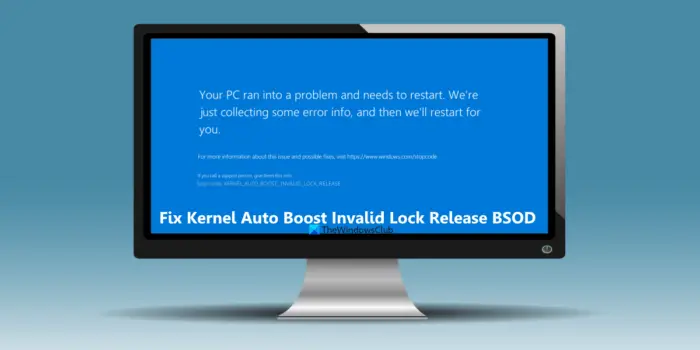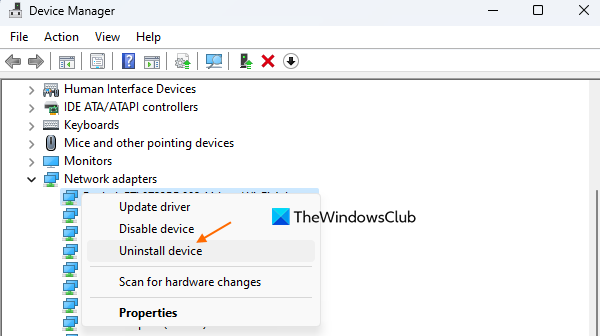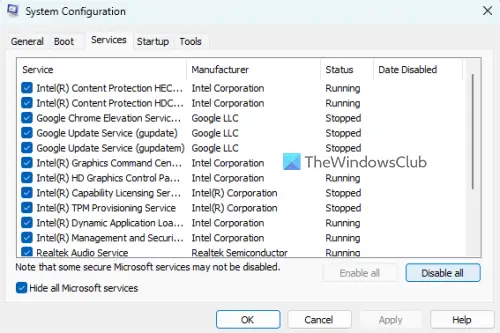A BSOD error (blue screen of death) or stop error occurs when your system crashes or shuts down unexpectedly by some problem. Windows users face these blue screen errors from time to time and these can be caused by a driver, faulty hardware, etc. One such blue screen error is KERNEL_AUTO_BOOST_INVALID_LOCK_RELEASE and we are going to talk about the solutions to solve this error on Windows 11/10 OS. Users get this error randomly when watching a movie, opening certain programs, playing some game, etc. Such an error is caused when a kernel thread (an interrupt handler or process) tries to release a lock that is not owned by it. If you also see this error, then you can use the options covered by us.

The KERNEL_AUTO_BOOST_INVALID_LOCK_RELEASE bug check has a value of 0x00000162. This indicates that a lock tracked by AutoBoost was released by a thread that did not own the lock.
Fix KERNEL AUTO BOOST INVALID LOCK RELEASE BSOD
To fix this KERNEL AUTO BOOST INVALID LOCK RELEASE blue screen error on your Windows 11/10 computer, you can use the fixes listed below. Before doing that, you should back up your important data, just in case.
- Disable Overclocking
- Unplug the Connected Devices
- Uninstall your wireless adapter
- Troubleshoot in Clean Boot State
- Perform Hardware Clean Boot
- Change or replace the faulty hardware component.
1] Disable Overclocking
One of the main causes of this Kernel Auto Boost Invalid Lock Release error could be PC overclocking. If you are speeding any of your system components (say CPU or GPU) more than the safe or specified limit, then it may result in overheating. And, if any of those components aren’t able to cool down to the threshold temperature within the required time, it will crash your system or shut it down unexpectedly and this BSOD error may occur. So, to solve this problem, you need to disable overclocking by accessing your UEFI settings or BIOS Settings on your Windows 11/10 computer.
In addition, if you are using some overclocking software, stop using it. You should uninstall that software and remove leftover files after uninstall.
2] Unplug the Connected Devices
This is an easier fix and it helped one of the users who had this same Kernel Auto Boost Invalid Release BSOD error. It can be possible that this error is caused because of the device(s) connected to your computer/laptop. If yes, then you need to unplug the problematic device.
To confirm, you can first view the BSOD log file in Event Viewer and check the details of this BSOD error. If the log file shows the error is linked to any of the connected devices (say your phone with a USB cable, keyboard, etc.), then unplug the connected device and restart your system. This should solve the problem and it shouldn’t appear anymore.
Related: Fix SESSION1 INITIALIZATION FAILED BSOD
3] Uninstall your wireless adapter

Check if your system crashes and you get this blue screen error after you connect to the WiFi. If yes, then it could be because of a corrupt or outdated Wireless LAN Driver. In this case, you need to uninstall your wireless network adapter driver. For this, follow these steps:
- Open the Device Manager You can open it using the File Explorer, Control Panel, Search box, or any other way
- Expand the Network adapters section
- Right-click on your wireless network adapter driver
- Press the Uninstall device option
- In the confirmation box, press the Uninstall button.
Now restart the PC and let Windows install it afresh. Windows will automatically find and install the compatible driver for your network adapter. This should help you in fixing the blue screen of death error.
Read: Network Adapter missing or not showing in Windows
4] Troubleshoot in Clean Boot State

This method worked for some users and this can also be helpful in fixing this error for you. If the problem is caused by some non-Microsoft service or program that uses that particular service, then troubleshooting in Clean Boot State can help you identify that culprit.
What you need to do is open the MSConfig or System Configuration utility with an administrator account on your Windows 11/10 computer and access the Services tab to disable all the third-party services. You should also disable Startup programs using the Startup tab. Press OK and restart your PC in a clean boot environment.
If the system works fine, then definitely there is some Startup program or third-party service(s) that is causing this blue screen error. To fix it, you need to manually enable those services and applications one by one and restart your system. If you encounter the same blue screen error after enabling a startup item or another service, then that would be the culprit that you need to disable or get rid of from your PC.
A lot of manual work is needed for this solution, but it would be worth it.
5] Perform Hardware Clean Boot
You may get this Kernel Auto Boost Invalid Lock Release BSOD error if a hardware device is not supported or incompatible with Windows 11/10 OS. In that case, you need to find out which hardware component that is. And, for this, Hardware Clean Boot comes in handy.
In this Hardware Clean Boot option, you need to open the Device Manager, and then disable the unwanted or non-essential hardware device drivers installed on your system. Right-click on a non-essential device driver and use the Disable device option. Restart your computer. If everything goes fine, then you will know which hardware component is causing the issue. If not, repeat this process until you find the culprit hardware component and then take further action.
6] Change or replace the faulty hardware component
This would be the last option to use. If the problem is with the CPU or the motherboard itself, then you need to change or replace that faulty hardware component. Visit the official service center of your laptop/desktop and let the technician identify the faulty hardware. You may get a replacement if the product is under warranty or change it.
Hope something will help.
Also read: How to find which Driver is causing the Blue Screen on Windows?
KMODE EXCEPTION NOT HANDLED Blue Screen on Windows 11/10
KMODE EXCEPTION NOT HANDLED is a blue screen error that occurs on Windows 11/10 OS. It can occur because of a misconfigured or invalid device driver or for some other reasons. If you see this error and want to fix KMODE EXCEPTION NOT HANDLED BSOD error, then use the following solutions:
- Disable Fast Startup
- Update your device drivers
- Run Microsoft Online Blue Screen Troubleshooter, etc.
How to fix APC_INDEX_MISMATCH Stop Error on Windows 11/10?
APC_INDEX_MISMATCH blue screen error occurs because of an incompatible audio driver and/or display driver on a Windows 11/10 computer. Thankfully, there are some handy solutions to fix this APC_INDEX_MISMATCH stop error. You can use fixes like disabling Realtek HD Audio Manager from Startup, updating display drivers, removing DisplayLink drivers, etc., to get rid of this problem.
Read next: Complete list of Windows Blue Screen or Bug Check Stop Error Codes.